|
 10/14/2006
- Eisenhower, Khrushchev, and AHF's own Imre Toth participate
in "Cold War Conversations: The Uprisings and Revolutions of 1956." 10/14/2006
- Eisenhower, Khrushchev, and AHF's own Imre Toth participate
in "Cold War Conversations: The Uprisings and Revolutions of 1956."
 The
American Hungarian Federation joined the Embassy of Hungary, the Embassy
of Poland, the Hungarian
Technology Center, Fairfax
County Development Authority, and the South County Secondary School
in hosting the event organized by the Cold
War Museum, who convened panels of diplomats, officials and historians
to discuss the 1956 Polish and Hungarian uprisings against the Soviets
and Communism. The event was opened by Fairfax County Supervisor Chairman,
Gerald Connolly, Hungary’s Deputy Chief of Mission Viktor Szederkényi
and Poland’s Cultural Counselor Mariusz M. Brymora. The
American Hungarian Federation joined the Embassy of Hungary, the Embassy
of Poland, the Hungarian
Technology Center, Fairfax
County Development Authority, and the South County Secondary School
in hosting the event organized by the Cold
War Museum, who convened panels of diplomats, officials and historians
to discuss the 1956 Polish and Hungarian uprisings against the Soviets
and Communism. The event was opened by Fairfax County Supervisor Chairman,
Gerald Connolly, Hungary’s Deputy Chief of Mission Viktor Szederkényi
and Poland’s Cultural Counselor Mariusz M. Brymora.
 After
Joseph Stalin’s death in 1953, Poland and Hungary tested the bonds
that tied them to the Soviet Union; America responded by expanding its
national defensive shield via the activation of its Nike Missile System.
The conference explored two major events that occurred during this period:
the Poznan Uprising in Poland and the Hungarian Revolution. After
Joseph Stalin’s death in 1953, Poland and Hungary tested the bonds
that tied them to the Soviet Union; America responded by expanding its
national defensive shield via the activation of its Nike Missile System.
The conference explored two major events that occurred during this period:
the Poznan Uprising in Poland and the Hungarian Revolution.
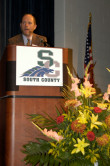 Conference
attendees had the opportunity to hear from three panels. The first panel
opened with a stirring documentary film produced by the Polish Embassy
to coincide with the 50th anniversary of the 1956 uprisings in Poland
and Conference
attendees had the opportunity to hear from three panels. The first panel
opened with a stirring documentary film produced by the Polish Embassy
to coincide with the 50th anniversary of the 1956 uprisings in Poland
and 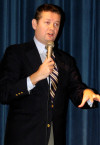 Budapest.
The film, "Poznan to Budapest" illustrated the historic ties
between the two countries and the horrors of the communist regimes that
included the brutal torture and execution of Hungarian child revolutionary
Peter Mansfeld. The panel included noted Polish historians talking about
the Polish uprising: Dr. Padraic Kenney, Dr. Krzysztof Persak, and Dr.
Marek Chodakiewicz. Budapest.
The film, "Poznan to Budapest" illustrated the historic ties
between the two countries and the horrors of the communist regimes that
included the brutal torture and execution of Hungarian child revolutionary
Peter Mansfeld. The panel included noted Polish historians talking about
the Polish uprising: Dr. Padraic Kenney, Dr. Krzysztof Persak, and Dr.
Marek Chodakiewicz.
 The
second panel focused on Hungary during the 1950s and in particular the
1956 Hungarian Revolution. Dr. Imre L. Toth The
second panel focused on Hungary during the 1950s and in particular the
1956 Hungarian Revolution. Dr. Imre L. Toth
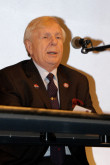 (Co-President
of AHF and the last surviving Secretary of the Revolutionary Committee
for the Ministry of Foreign Affairs for the Imre Nagy Government) provided
a unique, first-hand experience as he shared with us his role in the 1956
Hungarian government. (Co-President
of AHF and the last surviving Secretary of the Revolutionary Committee
for the Ministry of Foreign Affairs for the Imre Nagy Government) provided
a unique, first-hand experience as he shared with us his role in the 1956
Hungarian government.
 Dr.
Julia Vasarhelyi, now Senior Editor of Hungary's respected HVG magazine
and daughter of the Minister of Information in the Nagy government in
1956, recounted her family's experience and exile to Rumania after the
uprising. Dr. Charles Gati, author of Failed Illusions: Moscow, Washington,
Budapest, and the 1956 Hungarian Revolt joined Dr. Toth and Ms. Vasarhelyi
on the Hungarian panel. The first two panels were moderated by Christian
Ostermann of the Cold War International History Project the Woodrow Wilson
International Center for Scholars. Dr.
Julia Vasarhelyi, now Senior Editor of Hungary's respected HVG magazine
and daughter of the Minister of Information in the Nagy government in
1956, recounted her family's experience and exile to Rumania after the
uprising. Dr. Charles Gati, author of Failed Illusions: Moscow, Washington,
Budapest, and the 1956 Hungarian Revolt joined Dr. Toth and Ms. Vasarhelyi
on the Hungarian panel. The first two panels were moderated by Christian
Ostermann of the Cold War International History Project the Woodrow Wilson
International Center for Scholars.
 The
third panel, moderated by Francis Gary Powers, Jr, Founder of The Cold
War Museum, brought together Mr. David Eisenhower, The
third panel, moderated by Francis Gary Powers, Jr, Founder of The Cold
War Museum, brought together Mr. David Eisenhower,  grandson
of President Dwight D. Eisenhower, and Dr. Sergei Khrushchev, son of Soviet
Premier Nikita. "Today we can literally touch history" remarked
AHF Executive Committee Chairman Bryan Dawson-Szilagyi, before posing
a question to the panel. grandson
of President Dwight D. Eisenhower, and Dr. Sergei Khrushchev, son of Soviet
Premier Nikita. "Today we can literally touch history" remarked
AHF Executive Committee Chairman Bryan Dawson-Szilagyi, before posing
a question to the panel.
 Hundreds
of conference participants included high-school students, scholars, and
many who remember first-hand the hopes, horrors and disappointments of
1956. Many offered the panelists thought-provoking questions that ranged
from China's position on the Hungarian Revolution to US inaction and policy
in the Eastern Bloc to parallels between the 1956 uprising and recent
anti-government demonstrations in Hungary. Hundreds
of conference participants included high-school students, scholars, and
many who remember first-hand the hopes, horrors and disappointments of
1956. Many offered the panelists thought-provoking questions that ranged
from China's position on the Hungarian Revolution to US inaction and policy
in the Eastern Bloc to parallels between the 1956 uprising and recent
anti-government demonstrations in Hungary.
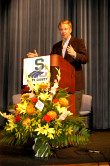 Breakout
sessions included the collection of oral histories from Cold War veterans
and family members by South County students. Ms. Linda McCarthy, Founding
Curator of the CIA’s Exhibit Center and Mr. Werner Jurtezko, a Cold
War G-2 operative imprisoned by the East German secret police (Stasi),
talked about their experiences and the importance of preserving Cold War
history. Breakout
sessions included the collection of oral histories from Cold War veterans
and family members by South County students. Ms. Linda McCarthy, Founding
Curator of the CIA’s Exhibit Center and Mr. Werner Jurtezko, a Cold
War G-2 operative imprisoned by the East German secret police (Stasi),
talked about their experiences and the importance of preserving Cold War
history. 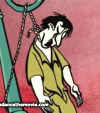 U.S.
Representative from Fairfax and Prince William Counties, Tom Davis, provided
closing remarks. U.S.
Representative from Fairfax and Prince William Counties, Tom Davis, provided
closing remarks.
The day ended with a special screening of Emmy-award nominated
Steven Fischer's and Craig Herron's animated documentary film, "Freedom
Dance: The Movie."
 Following
the conference, the Polish and Hungarian Ambassadors in Washington co-hosted
an evening reception for invited guests at the Embassy of Poland. Ambassadors
Janusz Reiter and András Simonyi underlined the historical friendship
and solidarity of the two nations, as well as their common resolution
in fighting for freedom and building democracy. The reception featured
both Polish and Hungarian cuisines and desserts. The American Following
the conference, the Polish and Hungarian Ambassadors in Washington co-hosted
an evening reception for invited guests at the Embassy of Poland. Ambassadors
Janusz Reiter and András Simonyi underlined the historical friendship
and solidarity of the two nations, as well as their common resolution
in fighting for freedom and building democracy. The reception featured
both Polish and Hungarian cuisines and desserts. The American  Hungarian
Federation expresses its thanks to Ambassador Reiter and Cultural Attache
Mariusz Brymora (seen here with AHF Co-President Imre Toth and Executive
Chairman Bryan Dawson Szilagyi) for both the reception and for the donation
of 200 copies of "Poznan to Budapest" film that will be handed
out at the October 20, 2006 Gala 1956 Commemoration at the Cosmos Club
in Washington, D.C. Hungarian
Federation expresses its thanks to Ambassador Reiter and Cultural Attache
Mariusz Brymora (seen here with AHF Co-President Imre Toth and Executive
Chairman Bryan Dawson Szilagyi) for both the reception and for the donation
of 200 copies of "Poznan to Budapest" film that will be handed
out at the October 20, 2006 Gala 1956 Commemoration at the Cosmos Club
in Washington, D.C.
 AHF
thanks the Sponsors that included Verizon, Northern Virginia Community
College, Marriott Fairfax at Fair Oaks, EnviroSolutions, Inc., Handyman
Concrete, K. Hovnanian Homes, and Vulcan Materials Company. AHF
thanks the Sponsors that included Verizon, Northern Virginia Community
College, Marriott Fairfax at Fair Oaks, EnviroSolutions, Inc., Handyman
Concrete, K. Hovnanian Homes, and Vulcan Materials Company.
 For
more information about the Cold War Museum, contact CWM's Francis Gary
Powers, Jr., at (703) 273-2381 or 1956@coldwar.org. For
more information about the Cold War Museum, contact CWM's Francis Gary
Powers, Jr., at (703) 273-2381 or 1956@coldwar.org.
|
 The
1956 Hungarian Revolution was the first tear in the Iron Curtain.
Hungarians from all walks of life rose up against insurmountable odds
to fight the brutal Soviet installed Hungarian communist government. Thousands
died fighting, others tortured and executed, while 200,000 were forced
to flee. 2006 marks the 50th Anniversary of the Hungarian Revolution. The
1956 Hungarian Revolution was the first tear in the Iron Curtain.
Hungarians from all walks of life rose up against insurmountable odds
to fight the brutal Soviet installed Hungarian communist government. Thousands
died fighting, others tortured and executed, while 200,000 were forced
to flee. 2006 marks the 50th Anniversary of the Hungarian Revolution.
AHF's work regarding the tragic events nearly 50
years ago, dates back to the early days of the revolution and
thereafter assisting tens of thousands of refugees. In 1956 the American
Hungarian Federation activated the second Hungarian Relief program for
the refugees of the 1956 Hungarian Revolution, providing $512,560.00.
With the support of the American Hungarian Federation, over 65,000 refugees
arrived in the USA. Get involved and help us continue our tradition of
helping our community! Join Us!
Downloads:
- The Hungarian Revolution - Uprising, Budapest 1956:
A synoptic treatise of a major political event of the 20th Century,
a historically tragic period in the life of a nation commemorating the
50th Anniversary of the Revolution and the fallen brave By: Attila J.
Ürményházi (Hobart, Tasmania) and edited by AHF Executive
Committee Chairman, Bryan Dawson-Szilágyi [download]
 Sign
up for the AHF mailing list. Sign
up for the AHF mailing list.
Your information is not shared!

- The American Hungarian Federation is helping to coordinate
events across the country and planning a year of events in
Washington DC that started in October, 2005! Join
Us! Also see our new 1956 Portal - www.hungary1956.com
- The 1956 Institute,
headed by Dr. Janos Reiner, is a great site devoted to exploring the
1956 Hungarian Revolution in English and Hungarian.
- www.celebratingfreedom1956.org
- The Cleveland Hungarian Revolution 50th Anniversary Committee (CHR50)
is organizing a major observance event of this important historical
milestone on October 21st and 22nd, 2006 in Cleveland, Ohio.
- Magyar
Radio Online - includes many audio files and an analysis in Hungarian:
"Ki húzta meg a ravaszt eloször 1956. október
23-án?" "Who was the first to pull the trigger?"
 Time
Magazine gave Hungarian Freedom Fighters the title "Man of
the Year" on July 1, 1957. "The Freedom Fighters filled the
empty bottles with gasoline and corked them with table napkins, making
what they called 'benzine flashes." Time
Magazine gave Hungarian Freedom Fighters the title "Man of
the Year" on July 1, 1957. "The Freedom Fighters filled the
empty bottles with gasoline and corked them with table napkins, making
what they called 'benzine flashes."- The Hungary
Page - offers information on 1956, the 1956 Olympics, the popular
"Nobel Prize Winners and Famous Hungarians," resources on
Trianon, Transylvania, History, Music, and more.
- Wikipedia
- the free, online encyclopedia that allows readers to manage its content!
- The 1956
Institute in Hungary (1956-os Intézet)
- The 1956
Hungarian Revolution Historical Documentation and Research Foundation
in Hungary - a source for thousands of photographs from the period
- The National
Security Archive at The George Washington University provides a
wealth of information on the 1956 Revolution available for download
in PDF.
- The
1956 Hungarian Revolution - a short chronology of events with pictures
- Pal
Maleter on Wikipedia - the military leader of the Hungarian Revolution
- www.sulinet.hu
has as site that transcribed many of the various speeches given before,
during, and after the revolution - a fascinating chronology from Nagy
to Mindszenty. (Hungarian)
- Az
1956-os Magyar Forradalom igaz története - in Hungarian.
"What the history books left out." Published by the 1956 World
Federation.
- Az
1956-os forradalom története Esztergomban - The Revolution
in Esztergom (in Hungarian)
- Arcok
és sorsok - a great site with photos and biographies of some
1956 Freedom Fighters
- Nagy
Imre október 23-án: Nagy Imre október 23-án
eleinte hallani sem akart arról, hogy a Parlamentbe menjen és
szóljon a tömeghez. Ám mégis megtette. Döbbenetet
érezhetett, amikor lenézett a Parlament ablakából,
s akkor is, amikor kifütyülték az „elvtárs”
megszólítást. Beszéde az alant álló
ismeretlen erovel szembeni aggodalmát és szorongását
mutatja.
Memorials Dedicated to 1956
"October 23, 1956, is a day that will live forever in the annals
of free men and nations. It was a day of courage, conscience and triumph.
No other day since history began has shown more clearly the eternal unquenchability
of man's desire to be free, whatever the odds against success, whatever
the sacrifice required."- President John
F. Kennedy,
on the first anniversary of the Hungarian Revolution.
- Denver, Colorado - statue and "Hungarian Freedom Park"
- Toronto, Ont - statue and park
- Erie, PA - Memorial and square (Thanks to v. Juhasz Ferenc,
AHF, VP)
- Fairfield, CT - Memorial plaque in Town Hall (2003)
- Berkeley Springs, WV - plaque, cemetery, and church (TX to
Mrs. 'Sally' Gyorik, Ft Vitez Baan OFP)
- Boston, Mass - Liberty Square statue and square by George Hollosy
- Los Angeles, CA - statue by Arpad Domjan (1966)
(TX to Czene Ferenc and LA Hungarians)
- New York - Plaque at East River/92d Str
- Lorantffy House, Akron, Ohio 1956 - Plaque
- North Olmstead , Ohio - Plaque and cemetery (Thanks to Dobolyi
Arpad & Juhasz Ferenc AHF VP)
- Loraine, Ohio - Statue under construction
- Miami, Fl - First Hungarian Church Stained Glass Windows
- Camp Kilmer - plaque now in New Brunswick, New Jersey
- Cleveland, Ohio - Cardinal Jozsef Mindszenty statue and square
- New Brunswick, NJ - Mindszenty statue and square
- Miami - Mindszenty Str. (27th Str) NW (TX to Tarr Sandor, Honorary
Consul)
- Budapest - statue/plaque at the Chain bridge in Buda by Ocsay
Karoly
- Korvin koz - statue of the young freedom fighter
- Budapest, Prime Minister Imre Nagy Gravsite and Memorial
- Budapest, II kerulet; Manheimer Statue
- Budapest, XIII kerulet: Park of Statues: granite obelisk
- Budapest, XIII kerulet: Park of Statues: Plaque of the martyrs
(2000 Oct. 23)
|
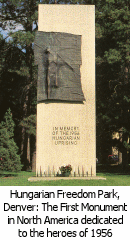
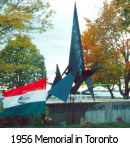
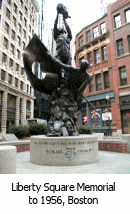
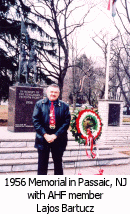
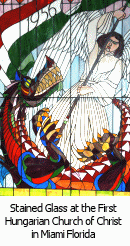

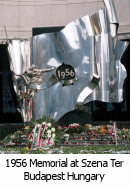
|
 Albert
Camus' Stirring Letter to the World: Albert
Camus' Stirring Letter to the World:
"The Blood of the Hungarians"
I am not one of those who wish to see the people of Hungary take up arms
again in a rising certain to be crushed, under the eyes of the nations
of the world, who would spare them neither applause nor pious tears, but
who would go back at one to their slippers by the fireside like a football
crowd on a Sunday evening after a cup final.
There are already too many dead on the field, and we cannot be generous
with any but our own blood. The blood of Hungary has re-emerged too precious
to Europe and to freedom for us not to be jealous of it to the last drop.
But I am not one of those who think that there can be a compromise, even
one made with resignation, even provisional, with a regime of terror which
has as much right to call itself socialist as the executioners of the
Inquisition had to call themselves Christians.
And on this anniversary of liberty, I hope with all my heart that the
silent resistance of the people of Hungary will endure, will grow stronger,
and, reinforced by all the voices which we can raise on their behalf,
will induce unanimous international opinion to boycott their oppressors.
And if world opinion is too feeble or egoistical to do justice to a martyred
people, and if our voices also are too weak, I hope that Hungary’s
resistance will endure until the counter-revolutionary State collapses
everywhere in the East under the weight of its lies and contradictions.
Hungary conquered and in chains has done more for freedom and justice
than any people for twenty years. But for this lesson to get through and
convince those in the West who shut their eyes and ears, it was necessary,
and it can be no comfort to us, for the people of Hungary to shed so much
blood which is already drying in our memories.
In Europe’s isolation today, we have only one way of being true
to Hungary, and that is never to betray, among ourselves and everywhere,
what the Hungarian heroes died for, never to condone, among ourselves
and everywhere, even indirectly, those who killed them.
It would indeed be difficult for us to be worthy of such sacrifices.
But we can try to be so, in uniting Europe at last, in forgetting our
quarrels, in correcting our own errors, in increasing our creativeness,
and our solidarity. We have faith that there is on the march in the world,
parallel with the forces of oppression and death which are darkening our
history, a force of conviction and life, an immense movement of emancipation
which is culture and which is born of freedom to create and of freedom
to work.
Those Hungarian workers and intellectuals, beside whom we stand today
with such impotent sorrow, understood this and have made us the better
understand it. That is why, if their distress is ours, their hope is ours
also. In spite of their misery, their chains, their exile, they have left
us a glorious heritage which we must deserve: freedom, which they did
not win, but which in one single day they gave back to us. (October 23,
1957)
AHF dedicates this work
to the memory of all our comrades who passed during those faithful days
of October, 1956.
- Read this in German, Hungarian, French, and Spanish on this AHF member
site, the [American
Hungarian Museum]
Join online!

|



